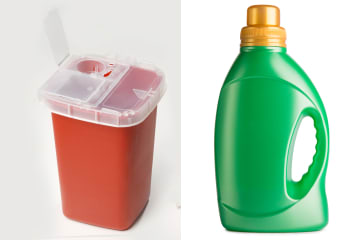
Why is safe needle use important?
Safe use of needles (and other sharps, such as lancets) lowers your risk of getting or spreading a serious disease. Some diseases that can be passed through unsafe needle use include hepatitis B, hepatitis C, and HIV.
How can you use needles safely?
- Use one needle and syringe for one person, one time.
Don't reuse needles or syringes, even if you are the only one using them. And don't try to clean them instead. Cleaning can't fully remove bacteria and viruses.
- Don't share insulin pens or blood-testing supplies with others.
Sharing these supplies can pass infections or diseases from one person to another.
- Refill your supplies before you run out.
Get what you need from your doctor or pharmacy before your supplies get too low. That way, you won't risk running out.
- Look for a needle exchange program if you need help getting sterile needles and syringes.
These programs are sometimes called syringe services. They're usually geared toward helping people who use illegal drugs. They help people who inject drugs get new needles and syringes. And they dispose of used ones safely.
Not all areas have needle exchange programs, but yours might. The website nasen.org/map can tell you if there are programs near you.
- Dispose of used needles, syringes, and other sharps safely.
Use a sharps disposal container. Put needles and syringes into the container right away after you use them. Don't overfill the container. And never put your fingers or hands inside of it.
Why is it important to get rid of sharps safely?
Used needles, syringes, and lancets (sharps) can be dangerous to people and pets. When sharps aren't disposed of correctly, others can get poked. Used sharps can spread diseases and cause injury and infection.
How can you get rid of sharps safely?
- Always put used sharps in a heavy-duty plastic container.
A container made to hold used sharps is best. You can get one from your doctor, a medical supplier, a drugstore, or online. If you don't have a special sharps container, you can use some types of household containers. They need to be sealed and labeled when you're done with them. Choose one that:
- Stays upright and doesn't leak.
- Is made of very strong plastic, such as a laundry detergent bottle.
- Has a strong, tight-fitting lid.
- Carefully put your sharps in the container right after use.
Don't force them in. Never put your fingers or hands inside the container.
- Don't overfill the container.
Stop at the fill line, if your container has one. If it doesn't, stop when the container is three-fourths full.
- Never put used sharps in the recycling bin, trash, or toilet.
Sharps can't be recycled. Neither can sharps containers. Loose sharps put in the trash can hurt waste workers.
- Follow your area's rules for getting rid of your sharps container.
Some areas have laws requiring special disposal of sharps containers. In other areas, you can throw them away in your household trash. Check safeneedledisposal.org for rules in your area.
Current as of: September 30, 2025
Author: Ignite Healthwise, LLC Staff
Clinical Review Board
All Ignite Healthwise, LLC education is reviewed by a team that includes physicians, nurses, advanced practitioners, registered dieticians, and other healthcare professionals.

